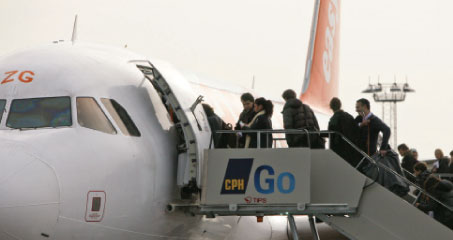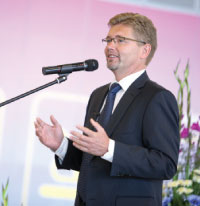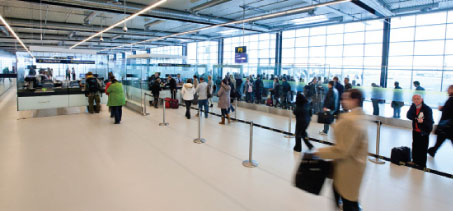
CPH Go launch customer easyJet grew by 60% at Copenhagen Airport in 2009. In 2010 this growth will be around 30% driven by the two new routes to Paris and Basel.
According to Nørland and Jørgensen, while LCCs initially focused on secondary airports, the business model has matured and shifted focus, resulting in a major share of today’s development taking place in primary airports.
“However, most airports have not adapted to the needs of the new customers. A ‘one size fits all’ mentality has prevailed, where business fundamentals such as market segmentation have been ignored because of the scale of investment required. Instead, all airlines have been offered the same product at the same price, no matter which facilities they have a need for,” Nørland explained.
At Copenhagen Airport, the decision was made to target both types of airlines, satisfying the needs of both network and low-cost airline business models. For the low-cost segment, the result is the brand new pier CPH Go, an investment of 200 million Danish kroner (€27 million), which went under the working name CPH Swift during planning and construction. Rather than being a stand-alone terminal, CPH Go is connected with the international terminals with which it shares check-in facilities, security and shopping areas. Split operations would have driven costs up and the airport reasoned that it has already achieved efficient operations in, for example, its common security area.
The facility’s launch customer, easyJet, was deeply involved in the project from the start. With help from the airline, Copenhagen Airport was able to ascertain what operational requirements the new facility should be designed to accommodate. A basic, scaled-down concept was developed, which its customer airlines must comply with in order to use the facility. The airline must be able to accomplish 30-minute turnarounds and must not require baggage transfer facilities. At least 90% of passengers must either check-in online, via mobile phone or use airport self-service kiosks, which have been installed in the CPH Go check-in area to limit the number of check-in desks needed. Also, the airline must accept that the check-in area is CPH Go-branded, which better utilises the desks, but leaves no room for the individual airlines’ own brands.
Unique price differentiation approved

CPH Go was officially opened on 31 October by Copenhagen’s Lord Mayor Frank Jensen. “The continued expansion and strengthening of Copenhagen Airport is a necessity for attracting more tourists and more business investment to the region. A strong international airport contributes to ensuring good access to Denmark, which we depend on in the international competition between cities and regions,” he said.
A major hurdle for the airport was the need to have a price differentiation between the full-service terminal facilities and the new CPH Go in order to attract LCCs to the new pier. Importantly for the airport’s many full-service carrier clients, there would be no discrimination, but a clear distinction between the two products. “You get what you pay for,” Nørland summarised.
Copenhagen Airport’s fees are subject to state regulation and the passenger charge for using CPH Go is DKK 20 (€2.7) lower than for international passengers in the airport’s other piers. However, as the airport’s charges are lowered overall, the fee for CPH Go is in fact 35% lower than what previously has been offered.
Jeff Salter, director of sales excellence & public accounts at Copenhagen Airports, said “With the number of low-cost passengers higher than ever at CPH, there is a raison d’être for CPH Go. A very large part of the low-cost traffic growth seen during the past 18 months has come about exactly because we had announced the opening of CPH Go. easyJet is the launch customer and grew by 60% at Copenhagen Airport in 2009. In 2010 this growth will be around 30% driven by the two new routes to Paris and Basel. These routes are specific examples of the importance of CPH Go as a strategic move by the airport, since it is unlikely that they would have become a reality without differentiated facilities and price.”
The passenger experience
Passengers bound for CPH Go need to go through Pier D, after which the moving walkways and wooden floors end and are replaced with a more basic 310m elevated walkway to reach CPH Go. The five to six-minute walk leads to steps, escalators and lifts that take passengers down to the ground level, where CPH Go spreads out along the apron.
The location of CPH Go is not a coincidence. The six aircraft stands in front of the pier already existed and used to be in use as bus gates.
The pier itself has three gates for intra-Schengen flights, one non-Schengen gate and two gates that are flexible and either let passengers through from the pier’s main lounge or from the area behind passport control. In addition to these six primary gates, there are two bus gates, one Schengen and one non-Schengen. These are not scheduled to be used, but provide additional capacity in case of operational irregularities that mean all other stands are taken.
Industrial, yet colourful look
CPH Go’s budget meant that the facility would look distinctly different from the remainder of Copenhagen Airport. However, this does not mean that CPH Go was less designed; it was only designed differently and with another selection of materials, emphasised Kelly Andrew Nelson, associate partner at Vilhelm Lauritzen Architects.

Jeff Salter, director of sales excellence & public accounts at Copenhagen Airports: “With the number of low-cost passengers higher than ever at CPH, there is a raison d’être for CPH Go. A very large part of the low-cost traffic growth seen during the past 18 months has come about exactly because we had announced the opening of CPH Go.”
Nelson and his colleagues wanted to find a style that matched the character of the low-cost carrier concept, something that expressed efficiency, no frills and quick turnarounds. They took inspiration from warehouses that have been converted into modern, trendy offices. While the pier’s epoxy floor and exposed ventilation pipes in the ceiling were entirely taken from industrial architecture, the glass walls and colourful graphics have been added to brand the concept.
Nelson realised the potential of the selected location, which is right before the aircraft stands and near to the airport runways. Making use of these spectacular view opportunities, the whole front wall is glassed, creating an engaging passenger experience. The walls within the building are also all made of glass, not limiting any light or views. In order to keep the front of the building close to the aircraft clear and open, offices, toilets, heating and ventilation systems, whose location is non-essential, were deliberately kept behind the back wall, which is covered in colourful artwork.
Green on a budget

The entire front wall of CPH Go is glazed, creating an engaging passenger experience with spectacular views of the airfield and maximum use of natural daylight.
CPH Go is the first project at Copenhagen Airport to make use of a groundwater heating system. In summer, the water is pumped up to cool the building, whereas the water heats the building in winter. This system, which in time will be connected with the rest of the terminal building, greatly reduces energy consumption.
“We have been green on a budget,” Nelson explained. He and his team have made numerous calculations on environmentally friendly ideas. If the green investments were commercially viable, they were incorporated into the plan, however, some ideas had to be dropped at the drawing board. An example of a discarded idea was rooftop solar panels, which – if incorrectly angled – would have caused glare on the aircraft.
CPH Go is a cornerstone in the ‘dual airport’ strategy of Copenhagen Airport, whereby it differentiates between the needs of point-to-point low-cost carriers and full-service network airlines. CPH Go is tailormade to the needs of low-cost airlines. The lower charges of CPH Go form the basis for many new routes and a substantial improvement in Denmark’s international accessibility, and the charges structure means that Copenhagen Airport will strengthen its position in the intensive competition among the major European airports.
Growing trend for LCC facilities
The opening of CPH Go continues the trend for dedicated LCC facilities, capitalising on the growth of low-cost traffic. mp2 – the dedicated low-cost terminal at Marseille-Provence – opened in 2006 and has subsequently provided a benchmark for the success that can be achieved by such facilities. It played a significant role in helping Marseille-Provence weather the economic crisis – low-cost traffic now accounts for 23% of the airport’s traffic, with a 61.8% increase in passenger numbers at mp2 last year.
Bordeaux’s low-cost ‘billi’ terminal has been similarly successful since its inauguration in June 2010. It is currently used by easyJet and Ryanair and also handles 23% of the airport’s traffic.
Other dedicated LCC facilities include Terminal 3 at Lyon-Saint Exupéry, Terminal 2 at Milan Malpensa and Pier H at Amsterdam Airport Schiphol. Further afield, Singapore Changi and Kuala Lumpur International Airport have also opened facilities exclusive to LCCs.







